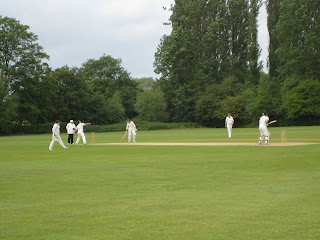http://www.cucc.
Now, cricket has this terrible reputation for being impossible to understand. Aaron Sorkin certainly seems to think so; there's a whole episode of Sports Night in which the cast and crew are trying to understand some incredible game so that they can talk about it on the show, and in an episode of The West Wing, President Bartlet quips, "Now, I am an educated man, Charlie, but when someone tries to explain cricket to me, all I want to do is hit him in the head with a teapot."
I'm here to insist that it's really, truly not that difficult to understand! Especially if you already know the basics of baseball. Part of the problem, I think, is the terminology -- so here it is, the basics of cricket explained using baseball terminology (forgive me, cricket fans).
Like baseball, you win by scoring more runs than the other team. But instead of a diamond of four bases to run around, there are two bases that you run back and forth between, and the outfield is 360 degrees all around.
Like baseball, there's a batter who hits a ball in order to be able to run. There's also an extra batter who runs back and forth. They alternate who actually receives the pitch. Here's a picture from our last match, which was against Oxford (click to enlarge). On the left-hand side, next to the umpire in black trousers, you can see the pitcher ("bowler") about to throw the ball. A bit to the right is the extra batter standing ready to run, and on the far right is the active batter with bat raised.
Like baseball, the batter is out if one of a few things happen:- the fielders catch a fly ball
- the fielders get the ball back to one of the bases before the one of the batters gets there
- the pitch gets past the batter and hits the wicket (3 sticks in the ground where a baseball catcher would be). [Note: there's no penalty for swinging and missing as long as the ball doesn't hit the wicket.]
- the pitch hits the batter in the leg and that leg was directly in front of the wicket. (Without this rule, the batter could just stand completely in front of the wicket and make it impossible to get out that way.)
Like baseball, after a certain number of outs, the inning is over. In cricket, it's 10 outs. If 10 outs don't happen, the inning ends after a fixed number of pitches.
The big difference: instead of alternating batting and fielding throughout the game, one team does all their batting first, then you have a tea/lunch break, then the other team does all their batting. To be honest, I'm not a fan of this part, because it means that the team that bats first is playing in a vacuum and doesn't know how many runs they'll really need in order to win, whereas the second team simply has to get one more than their opponents.
So there you go! Not so bad, right? If you want to know more, Wikipedia's entry is pretty handy. It only remains to say that it's really fun to watch people's reactions to an American girl playing cricket. For one thing, it's not a super-common sport for women just yet, but more to the point Americans just don't know anything about it. Generally, people are surprised, amused, and impressed, in roughly that order.

No comments:
Post a Comment